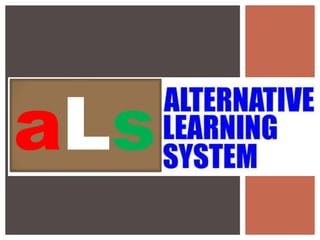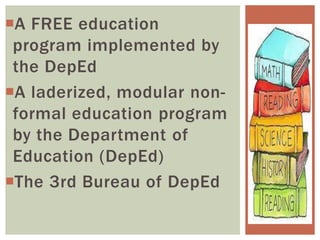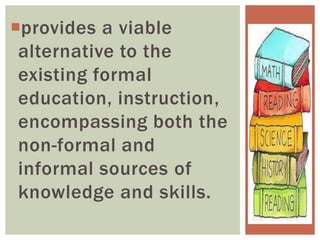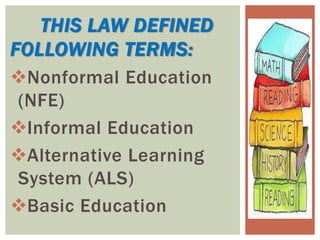Alternative Learning System
- 1. aLs
- 2. WHAT IS ALS?
- 3. ?A FREE education program implemented by the DepEd ?A laderized, modular non- formal education program by the Department of Education (DepEd) ?The 3rd Bureau of DepEd
- 4. ?Benefits those who cannot afford formal schooling and follows whatever is their available schedule
- 5. ?provides a viable alternative to the existing formal education, instruction, encompassing both the non-formal and informal sources of knowledge and skills.
- 6. ALTERNATIVE LEARNING SYSTEM ? Teachers that are involved in this program are called ¡°Mobile Teachers¡± for reasons that they often go about teaching in rural and depressed areas where a formal classroom is not available.
- 7. HISTORICAL CONTEXT OF ALS
- 8. ? that aimed to eradicate illiteracy and promote functional literacy for all peoples of the world. EFA (Education for All)
- 9. The Philippine Government put in place the following legal measures and commitment that serve the basis for the introduction of ALS in the Philippine Educational System
- 10. 1. REPUBLIC ACT 9155: The Governance Act of Basic Education
- 11. THIS LAW DEFINED FOLLOWING TERMS: ?Nonformal Education (NFE) ?Informal Education ?Alternative Learning System (ALS) ?Basic Education
- 12. 2 EXECUTIVE ORDER NO. 356: Renaming the Bureau of Nonformal Education (BNFE) the Bureau of Alternative Learning Systems (BALS)
- 13. Functions of BALS ?To adress the learning needs of all marginalized groups including the deprived, depressed and undeserved citizens ?To coordinate with various agencies for skills development of the learners
- 14. Functions of BALS ?To expand access to educational opportunities for citizens of different interest, capabilities, demographic, characteristics, and socio-economic origins and status
- 15. Functions of BALS ?To promote certification and accreditation for basic education of alternative learning programs both non- formal and informal in nature.
- 16. 3 Education for All (EFA) Plan by 2015
- 17. TASKS OF EFA ?Develop and strengthen the DepED¡¯s BALS and mandate it to serve as the government agency to guide the development of country¡¯s ALS.
- 18. TASKS OF EFA ?Make available public funds for ALS program of GOs and NGOs subject to the guidelines of BALS.
- 19. TASKS OF EFA ?Build and develop A constituency for ALS development.
- 20. TASKS OF EFA ?Conduct research and studies to test cost- effective options for delivering quality ALS.
- 21. TASKS OF EFA ?Undertake an inventory of available resources in localities for literacy interventions outside school.
- 22. TASKS OF EFA ?Ensure a vigorous and credible system for reliably assessing. Measuring, validating and communicating competencies acquired through NFE and Informal Education.
- 23. Who are the target learners of ALS? Elementary and secondary school dropouts Youth and Adults although in school but over-aged for grade 6 and 4th Year Unemployed/underemployed OSY¡¯s and adults
- 24. Who are the target learners of ALS? Industry-based workers, housewives, maids, factory workers, driver Members of cultural minorities/Indigenous People (IPs) Persons With Disabilities (PWDs)/physically Challenged Inmates, rebel/soldier integrees
- 25. How Does ALS Work? Students who are interested in enrolling in an ALS class are encouraged to visit Community Learning Centers (CLCs). Oral and written tests will be given to assess the student¡¯s/pupil¡¯s competency level.
- 26. How Does ALS Work? Applicants who have not attended any formal schooling before will be enrolled in Basic Literacy Program where basic reading and computing skills will be taught before moving them to advanced classes.
- 27. How Does ALS Work? Passers of either the Elementary or Secondary Level gets a certificate which bears the signature of the Secretary of the Department of Education. This allows a passer to be integrated into formal education and also gives them the chance to enroll for a college degree or technical courses.
- 28. ?Options and Opportunities for ALS Passers Can enroll for college Enter TESDA/MeralcoFdtn./Technical Schools Enter other non-formal training programs Enter Formal training programs Look for work opportunities Enrol or re-enrol in formal elementary or secondary education
- 32. SETTING Community Learning Centers School
- 33. TEACHER ? Facilitator/instructional Manager ? Must be trained in ALS ? Must be College graduate (for A&E program) ? Must be HS Graduate or even less (for literacy ? Programs) ? Called a Classroom Teacher ? Must be licensed/Professional ? Teacher ? Must be an education
- 34. AGE No age requirements Age is required for every school level.
- 35. Curriculum With Five Learning Areas/STRANDS Communication Skills Critical Thinking & Problem Solving Sustainable use of Resources/Productivity Develop of self & sense of Community Expanding ones world vision With 5 Major Subjects English Filipino Science Math Makabayan
- 37. TEACHING METHODOLOGY use of ANDRAGOGY ¨C science of adult learning use of PEDAGOGY ¨C the science of learning among children
- 38. ASSESTMENT OF LEARNING ? ABL Test (For the basic Literacy Program) ? A&E Test (For A&E Program) for the elementary and for High School Equivalent levels ? End of the Year Achievement Test for Elementary and High School levels.









































